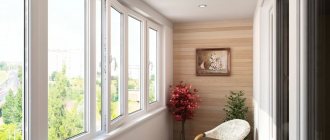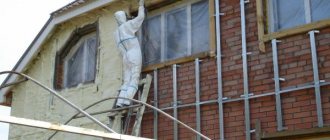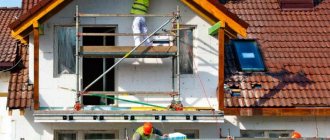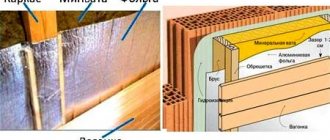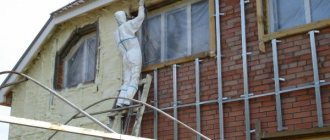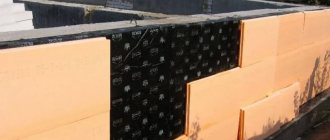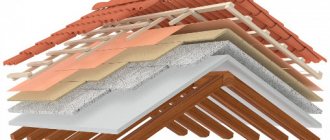In order to lighten the weight of the window frame, it is made of aluminum.
This replacement reduces the pressure on the balcony, but due to the properties of the metal it has problems with energy efficiency.
Aluminum conducts heat well, which adds problems when creating the desired indoor microclimate. Therefore, the aluminum window profile must be insulated.
Insulation of aluminum window structures
When an aluminum frame is used for glazing, one cannot fail to note some of its properties: along with high strength, lightness and low price, this material has high thermal conductivity, which not everyone considers a positive characteristic.
The aluminum profile forms vertical posts and horizontal crossbars, thus the glazing contour is divided into sectors. Inside each sector, either a window with opening sashes, or “fixed” glass (fixed), or an opaque panel is installed.
In some cases, a balcony or loggia is equipped with single glasses inserted into an aluminum profile. The cost of such structures is low. However, all costs for insulation are borne by the residents.
There are several options for insulating such a window:
Insulating aluminum windows by installing a second row of glazing is the cheapest and easiest way to save a balcony from freezing, and also provides a good level of sound insulation. This technique is also used when it is not possible to dismantle the aluminum profile with which your loggia is equipped. However, this method has a drawback. A window closed by an internal thermal circuit is quite difficult to clean, and not every loggia can withstand a large mass of glazing. As a result, this method is used quite rarely.
In some cases, the loggia is completely freed from glazing: the entire aluminum frame is removed, and a “warm” contour is installed in its place. But insulation in this way is possible if the loggia or balcony has independent glazing within one floor.
With through glazing covering several floors, in order to insulate the window, the third method is most often used. The opening sashes on the PVC window structure are replaced, and the “fixed” glass is removed and double-glazed windows are installed in their place. Then, using sandwich panels, the remaining sections of the old glazing are insulated.
If insulation is carried out in this way, then the loggia and balcony can be safely used as a pleasant addition to the living space all year round.
Materials
To insulate aluminum windows you may need :
- Mineral wool. It is necessary to select the thickness, as it may not fit the slopes. The average price for insulation with a thickness of 50 mm and more than 2 m/2 is from 500 rubles/roll.
- Fiberglass. You also need to select the thickness. The cost of pieces 1230x610x50 mm is from 800 RUR/pack (12 pcs.).
- Basalt wool. The problem with sizes is similar to the previous options. The price for a package of 8 pieces 1200x600x50 starts from 700 rubles.
- Polyurethane foam. For insulation, you can use a regular one, but the fireproof version is of better quality. The price for 1 cylinder with regular foam is 300-400 rubles, and for fireproof foam - from 700 rubles.
- Penoizol. It is necessary to select such insulation of sufficient thickness, as well as with a special coating that will protect it from external influences. The price of penoizol ranges from 300-400 rubles/m2, but with increasing thickness and protective qualities it can cost from 800 rubles/m2.
- Penofol. Analogue of penoizol. Price from 150 RUR/m2.
- Thermal insulating film. It is necessary to select dense and high-quality material, since a film that is too thin will not perform its functions. You also need to pay attention to transparency. The cost is from 110 rubles/linear meter.
- Adhesive for polystyrene foam. You should choose a frost- and moisture-resistant option, since most often it will be used outside the building. The cost for 25 kg of dry mixture is on average 450 rubles.
- Expanded polystyrene. Sheets of a certain thickness (from 30 mm) are required to create a good insulating layer. Price per sheet. 1180x580x50 mm is 200-250 RUR/piece.
- Plaster mesh. Made from fiberglass. Needed for applying plaster over polystyrene foam. The price is on average 200 rubles/roll (10 m long, 1 m wide, with a 5x5 cell).
- Plaster. Costs on average 400 rubles for 30 kg of dry mixture. Needed to create a protective coating on polystyrene foam, as well as cladding the exterior of the building.
- Sealant. The most common is the silicone option, as it is well suited for sealing cracks in windows. The cost is 400-500 rubles per cylinder.
Cold and warm glazing of the loggia
A window made of aluminum profile will not be able to retain heat at the proper level, which is why such glazing is called “cold”. In winter, a loggia (balcony) with such glazing cannot be used as additional living space due to the so-called cold bridges. Through them the air inside will be cooled. So that the loggia can be fully used as a study or winter garden, “warm” glazing is used, which involves the installation of plastic windows. The advantage of PVC structures is a high degree of thermal insulation, but a “cold” aluminum window is much cheaper to install. Thus, when choosing the type of glazing, it is necessary to decide how the loggia will ultimately be used.
Of course, you can carry out insulation yourself, however, so that a balcony or loggia not only serves as a reliable shield from the cold for a long time, but also pleases the eye with a neat appearance, it is advisable to seek help from professionals. will carry out all the necessary work, all you have to do is enjoy the comfort of home, looking through a warm window at the bad weather or winter cold!
Legal aspect of changing the facade of a building
Any changes made to the enclosing structures of the building's facade (and these include balcony parapets), as well as glazing that does not correspond to the general architectural concept, require permission from local executive authorities.
Relevant regulations have been adopted at the level of each subject of the Federation.
In Moscow, this is Government Decree No. 508 of October 25, 2011 “On the organization of reconstruction and (or) redevelopment of residential and non-residential premises in apartment buildings.” One of the points of this Resolution provides for the mandatory obtaining of permission if “the shape of window and door openings in external enclosing structures changes;).
The procedure for obtaining such permission consists of five successive stages and the approval of about 40 documents.
The cost of services of law firms (in Moscow) providing services for coordinating changes to facades for a full package is about 1,000,000 rubles. There is something to think about.
How to insulate an aluminum profile on a balcony before it turns into a piece of ice?
From the author: Hello, dear readers! Now I want to share my experience so that you know ,
how to insulate an aluminum profile on a balcony yourself and achieve maximum effect.
Once, when installing a balcony made of metal profiles in an office building, the customer considered that the temperature on the sixteenth floor in winter would be an order of magnitude higher than below, and refused artificial insulation. As a sensible person, I tried to insist that such a decision was wrong, especially if this area would be used not as a place to relax, but as a conference room with a gorgeous view of the city.
In response from the customer, I only heard that I was trying to rip more money from him, and that all the arguments I was giving were stupidity, and that’s all.
Construction work was carried out in winter, so he could not immediately assess the scale of the tragedy. My wait was not entirely long, since with the first cold weather that hit in the second month of autumn, I received a call from the same customer, who considered that now insulating aluminum windows on all office balconies would be more acceptable.
Having explained to him that these works involved almost complete dismantling of the structure, and voicing the amount, I was again sent by this character to places where no one had gone before. A little more than a month later, just at the time when the first December frosts begin to draw patterns on the windows of our houses and apartments, my phone again burst with a call from the same person, who tearfully apologized, realizing that the price I quoted then was the top. tolerance.
Alas, high-altitude work is a service that is paid differently in summer and winter, and rude words addressed to me resulted in a fine. However, the total amount was still lower than usual, and we got to work. The only conclusion to be drawn from this is the proverb that the miser pays twice. And in the case of insulating a balcony with aluminum profiles - even three times.
We insulate a balcony with panoramic glazing yourself
Important nuances
There are significant differences in the insulation of panoramic balconies and loggias, caused by the peculiarities of these structures. The balcony is always located on a slab protruding beyond the load-bearing walls of the building and remains open on several sides. The loggia is built into the facade of the house so that only its front part borders on the street space. From the point of view of openness, a balcony is a colder room and therefore requires more costs for thermal insulation.
The structure of the loggia is reinforced with capital walls, which avoids its deformation during thermal insulation work.
Organization of balcony insulation at the design stage
Despite the fundamental differences in the structure of a panoramic balcony and a loggia, the same technologies are used to insulate them. Some of them are used at the stage of building a house, others - when it has already been put into operation.
To prevent heat loss, the main source of which is the glass surface, it is necessary to choose the right light transmitting structure. The best option would be “warm windows”. This term should be understood as enclosing structures with:
- insulated profiles. Standard window systems use aluminum frames, which are cold frames. For additional thermal insulation, they are equipped with thermal bridges - inserts made of polymer materials with low thermal conductivity. Also “warm” are windows with a plastic profile whose thickness is at least 80 mm;
- energy-saving double-glazed windows with optimal heat transfer resistance - 0.78 m²·K/W. They use at least double low-e glass and the chamber is filled with argon. This prevents heat loss from the premises and improves sound insulation.
Windows with single-chamber double-glazed windows have a heat transfer resistance of 0.35 m²·K/W, which is half the required value. It is not recommended to glass a panoramic balcony with them, as they will be cold. Single-chamber double-glazed windows are used only if there is a risk of overloading the base of the balcony. In this case, glass with an energy-saving coating, argon chamber filling and a thermal bridge is used.
Organization of insulation of a balcony using “warm” glazing
Thermal insulation of a balcony with “warm” window systems is carried out in the following sequence:
- dismantling old glazing. Cold windows are removed along with their frames, the opening is cleaned, and it is leveled/adjusted for the installation of a new structure;
- installation of “warm” frames. In this case, you need to take care of their correct installation. It involves the use of dowels to secure the structure. This will ensure a strong and tight fit of the frames to the walls;
- installation of double-glazed windows. Their upper part is inserted into an H-shaped guide, and the lower part is supported on a rubberized profile. To ensure the tightness of the structure, the glass is pressed to the frame with rubber seals.
A properly installed “warm” window is the key to preventing heat from escaping into the street.
After installing the structure, all cracks and gaps are filled with polyurethane foam. If the panoramic balcony is long, it is recommended to equip it with thermal compensators - elements of linear expansion. They are necessary to prevent deformation of the structure over time under the influence of external factors. Thanks to them, a gap of 5 mm is formed in the frame, allowing the glass to slightly expand/contract under the influence of ambient temperature, without compromising their appearance or the tightness of the structure.
The thermal compensator is installed in increments of 4 m for white profiles and 2.5 m for colored ones
How to insulate a balcony with already installed panoramic windows
If the balcony is already glazed, but the structure is cold, reducing heat loss will be problematic. In order to maintain a stable temperature inside the apartment, you can use the following insulation methods:
- thermal insulation of all non-glass surfaces of the structure - floor, walls and ceiling. Then the balcony will become a kind of layer between the apartment and the street, preventing heat loss from the living space. But you shouldn’t expect that it will be comfortable to stay on it during the cold season; the temperature there will be only a few degrees higher than the street temperature;
- connecting space to room. This is convenient because the balcony is automatically included in the central heating system of the apartment. But this option is complicated by the need to obtain permits for redevelopment, financial costs for refurbishing the premises, and its further heating;
- installation of a heated floor system. This method of thermally insulating a balcony structure is convenient to use if it is not possible to connect it to a room due to the complexity of the process or lack of funds.
Is this high-altitude work?
Yes, you might be wondering why the insulation of aluminum balconies is high-altitude work, because the process is entirely carried out from inside the room. This is true, but if you are the owner of a panoramic structure that has already been completely installed, and you decide to conserve heat only a few years later, then it must be completely dismantled. Not many construction teams would dare to remove windows on the sixteenth floor of a high-rise building in the cold, and even with possible strong winds.
In my short story, which I cited a little higher, the situation was exactly such that not every master who does not have experience working at heights will give the go-ahead to carry out such work. And since such a phobia is the most common after the fear of the dark, finding someone with enough courage will not be easy.
Content
- Replacing cold insulation with warm insulation
- Option one
- Option two
- Third option
- Stages of work
- Is it possible to insulate cold glazing yourself?
- Advantages of insulating a cold loggia
- Legal aspects
- How to insulate a cold aluminum profile
From the outside, facade glazing looks impressive, but from the point of view of residents, its practicality is in question. Loggias with this type of glazing are cold, so often the first thing buyers want is to insulate it or replace it with a warm one. Insulation of aluminum façade glazing profiles can be carried out in different ways.
Replacing cold insulation with warm insulation
It is impossible to dismantle a loggia whose structure has load-bearing supports, so it is often necessary to consider options for insulating what is there. Heat in a cold system flows away in several directions:
- through a cold aluminum circuit, crossbars, jumpers, etc.;
- through single glass;
- through cracks in places where the insulation structure adjoins the walls;
- through the concrete surfaces of walls adjacent to neighbors - of course, this has nothing to do with the glazing contour. but it is very important if there is a question about insulating a loggia or balcony in general.
Photo 1. Modern insulation of aluminum profiles for facade glazing.
There are several options for solving this problem, each of which has its own pros and cons.
Option one
The first method is to replace the glass with double-glazed windows and replace the opening sashes with PVC windows. In this option, vertical aluminum racks are insulated with a sandwich panel. This is the best option for cold panoramic glazing of a balcony. That is, all opening sashes made of aluminum profiles must be replaced with plastic windows with warm double-glazed windows. In place of the dismantled glass, double-glazed windows are installed using specially designed profiles. The remaining sources of cold - cold bridges - aluminum racks and horizontal crossbar profiles are insulated from the inside using decorative finishing with sandwich panels.
With this method, from the outside the loggia will look like an ordinary balcony with PVC windows. If facade panoramic insulation is installed throughout the house, such a solution will distinguish your loggia from the general appearance of the facade, which can lead to a conflict with the local executive authority.
Option two
The second option is to replace the façade glazing and insulate the lintels. This technology allows for insulation work to be carried out without changing the appearance of the house facade. Insulation of panoramic glazing is carried out from the inside. Installed glass with opening aluminum sashes is removed, and plastic frames with blind and opening sashes and two- or three-chamber double-glazed windows are built into the aluminum frame. The aluminum frame is insulated from the inside with penoplex, and decorative boxes are installed on the insulation.
This is a rather labor-intensive but effective method. The work is carried out from the inside; from the outside, the concept of the appearance of the facade does not change.
Third option
Another insulation option allows you not to affect the facade structure. A warm contour made of PVC structures is mounted from the inside parallel to the panoramic glazing. This creates double glazing. With this option, excellent performance in terms of sound insulation and heat transfer is achieved, but maintaining the structures is not entirely convenient, since efforts have to be made when washing the sides of the glass between the PVC glazing and the façade structure. To wash, you will have to remove the double-glazed windows. But this is the cheapest and most accessible option of all insulation options.
Photo 3. Replacing cold facade glazing with warm one.
In addition, you need to take into account that the double circuit will to some extent eat up the useful area of the balcony. In addition, due to several glasses that become dirty, the view from the loggia can significantly deteriorate.
It should be noted that in many large cities there is a decree regulating that the replacement of facade glazing must be carried out without changing the appearance of the facade. In some cases, it may even be necessary to coordinate the project with the management company.
Stages of work
If you are interested in replacing cold facade glazing with warm one. The following stages of work await you:
- Measurement of structures and approval of the project: a surveyor comes to your apartment, takes measurements, and draws up an estimate.
- Prepayment is required.
- After 2-3 weeks, new windows, double-glazed windows, and components are delivered to the address.
- The glazing is being dismantled. The installers remove the glazing beads from the inside. In some cases, the help of industrial climbers is required, who remove the covers of the crossbars and racks from the outside of the façade glazing. Glass and sashes are dismantled.
- Glass is replaced with double glazing. Installation of plastic frames with insulation of cold facade glazing is being carried out. Thermal bridges made of polyamide are built into the facade racks and crossbars, which will create a thermal break in the aluminum system, eliminate cold bridges and increase the heat transfer coefficient of the structure. Then the double-glazed windows are inserted into the blind frames.
- The junctions of the side walls with the new glazing are insulated with polyurethane foam and butyl tapes. In some cases, it is necessary to insulate interfloor ceilings with penoplex and penofol. The installation seams are covered with plastic trim or metal flashings.
- A new finish for the loggia is being ordered.
Is this even real?
Insulating a loggia with aluminum windows is as realistic as doing a double somersault. Yes, it will cause a little trouble, but patience and work will grind everything down. You will need a little knowledge and my experience, which I will be happy to share right now.
Many people say that the insulation efficiency drops every time you want to increase the amount of glazing in a room. I assure you - this is not so, and if you rented or bought an area that is made very cold due to the large number of windows, then you can insulate them too.
A simple solution that may not seem entirely reasonable is to cover part of the glass. For some, this seems nonsense, although this option has a right to exist. If you do not need to create an extensive view from the window, and panoramic glazing on the loggia was not your idea, then nothing will stop you. Of course, with a high degree of probability, you lose the internal volume of the room, but it does not disappear, but only begins to serve you in a different role.
I am not telling you now that you will need to completely remove the entire lower part of the balcony. I have come across cases where we sewed up the window along with the glass. By insulating it on both sides, you will thus get a wall made of insulation, which will contain the high temperature in the room much better.
But, before resorting to such radical measures, think twice about whether you need it so as not to throw money away. It is also worth paying attention to whether this will interfere with the mechanical actions of the opening windows. Agree that it would not be very cool to sew up the lower part of the balcony so that the upper part cannot open.
Insulation of a balcony with a brick parapet
Insulating material will help to effectively insulate a brick balcony.
The facades of new houses mostly form a single architectural composition. Violating its integrity by piling up additional materials for insulation is unacceptable or is associated with multiple bureaucratic approval delays. The best way to insulate balconies with cold glazing is to finish the interior with insulating materials.
A balcony or loggia often has a parapet made of brick. Installation of aluminum windows with this design occurs directly on the top row of bricks. The insulation of such a room will be effective due to the fact that insulating material with low thermal conductivity can be laid to the parapet wall.
Let's get straight to work
Before insulating a loggia with aluminum glazing, you need to carry out some preparatory steps, without which the insulation may be useless.
- Clean the entire aluminum profile of unnecessary elements. Remains of putty, polyurethane foam or other construction debris - remove all this. In small quantities they will not greatly affect energy saving, but the inconvenience during installation will be obvious.
- Seal any unnecessary holes or gaps in the profiles. It often happens that when installing the frame, a screwdriver might come off or a grinding machine might slip. There were no defects of such a scale that you would have to throw it away or cut off a part, but you may suffer a little while insulating it. An ordinary sealant will help you solve this problem.
- Choose insulation. In this case, since the process will involve small objects, many experienced builders suggest using ordinary construction foam. I do not recommend resorting to such drastic methods because it can deform the frame, which will create unnecessary problems when installing the windows themselves. The most appropriate, in my opinion, is to use mineral wool. In this case, you can purchase a roll rather than plates, which will be cheaper, and fill all the cavities in the same way.
- Prepare your instrument. If you use polyurethane foam, all you need is a special gun into which the cylinder is inserted. If your finger fell on mineral wool, then a small spatula, a stationery knife and a tape measure will be enough.
If you don’t know how to pour foam correctly, you can watch how to do it in the video below:
So, we have decided that there are two material options with which we can insulate an aluminum balcony - foam and cotton wool. A few notes to keep in mind when dealing with the first one:
- do not overdo it, because a large amount of material can lead to deformation of the profile itself;
- Buy more construction foam than you need. You see, if there is not enough of it, then it will be an order of magnitude worse than the case when it remains. It should dry all at once, and not in parts after additional purchase. It’s better to stay, because it can always come in handy;
- Fill the profile evenly and penetrate into all crevices. This is the only way you will achieve maximum results.
If, when insulating an aluminum loggia, you use my choice, which appears in the form of mineral wool, then do not forget that correct calculations will help you save a lot. The main advantage is that you will not in any way affect the size, shape or stability of the aluminum frame itself. We calculated how much to cut, cut it, placed it, straightened it with a spatula - and voila! All is ready!
Tools
To insulate windows you need to prepare :
spray foam gun;- putty knife;
- drill and mixing attachment;
- thermal imager;
- building level;
- gun for a sealant bottle;
- putty knife;
- stationery knife;
- construction hair dryer;
- vacuum cleaner or compressor.
Let's make a small conclusion
The first thing you should have understood for yourself is that this process will not take a lot of effort and money from you if you follow the instructions and do not want to save on heat. Learn from other people's mistakes. I described one of them at the beginning of the article, but I don’t plan to talk about the next one, because I’m sure that my advice will be useful to you.
The main mistake people make is the desire to always save money. Thinking that it won’t be useful now, but it won’t be difficult to do it later, people lose precious money, spending it on useless actions in the form of dismantling and reinstalling.
Take care not only of your wallet, but also of your health, which will definitely deteriorate not only from excessive physical exertion, but also from hassle.
Friends, remember that you need to save in moderation and on acceptable things. Without insulating any part of the apartment, you can spend a colossal amount of money on heating or purchasing additional heating sources. Yes, they will always come in handy, but do not forget that a balcony or loggia is a part of an apartment or office that is in contact with the outside world on each side, and this is also the only place where it is prohibited to install radiators. Fighting the cold there is a battle that must be won before it even begins.
In accordance with applicable law, the Administration disclaims any representations and warranties that may otherwise be implied and disclaims liability in relation to the Site, the Content and its use. More details: https://seberemont.ru/info/otkaz.html
Was the article helpful?
Tell your friends
Aluminum sliding loggias
Sliding aluminum loggias today confidently occupy the niche reserved for them. Everything is very simple. It has already been proven in practice that an aluminum profile is not only easy to install and operate, but also reliable. Modern balconies can be glazed in different ways, but it is necessary to preserve as much space as possible for personal use. You can install plastic windows on the balcony that open and close inward. However, loggias made of aluminum profiles really allow you to save as much usable space as possible. This type of translucent aluminum structures simply moves along the upper and lower profiles using specially installed rails and hinges.
The system of aluminum profiles for glazing balconies and loggias includes an aluminum frame with guide profiles and shutters on rollers. The frame can be painted in any color using the powder coating method. The standard profile width is 64 millimeters. You can design two-runner or three-runner options. The doors move along guide rails. The number of leaves can be from one to six. The thickness of the glass is four millimeters. Glazing using the system provides sound insulation of 20-27 dB. The doors are sealed together using a brush seal. The movement of the doors occurs according to the principle of a sliding wardrobe, that is, in one plane.
How to insulate aluminum windows with your own hands
In winter, even a glassed-in balcony can freeze, especially if there is severe frost outside. To make it warmer on the balcony, when the autumn cold sets in, you need to think about how to insulate the balcony windows. The insulation procedure depends on the type of windows.
Insulation of wooden windows
Wooden windows are environmentally friendly and completely safe. They easily allow air into the room. You can insulate wooden balcony windows with the following materials:
1. Wet paper. This method of insulating windows is very cheap. Wet paper is pushed into the cracks and the sealed cracks are then glued with strips of paper on top.
2. Foam rubber. Foam rubber cut into pieces is placed in the window slots. The cracks are sealed on top with pieces of fabric.
3. Sealant and sealant. This method of insulating wooden windows is quite reliable and effective. The windows must be removed from their hinges and a groove cut around the perimeter of the sash. After this, a seal is installed, and sealant is laid in the places where the glass joins the wooden sashes. The assembled window structure is put back into place.
4. Installation of roller shutters. Such shutters can retain about 15% of heat in a room.
5. Special putty. It is prepared from chalk and plaster. All window cracks are carefully coated with the finished putty.
Insulation of aluminum windows
Aluminum windows have a fairly long service life. Only due to the high thermal conductivity of aluminum in winter, a balcony glazed with such windows quickly becomes cold. To retain heat in the room, it is necessary to make a thermal break made of polyamide between the aluminum profile during glazing. This is the only way to avoid annual worries about the quality insulation of aluminum windows.
Insulation of plastic windows
Plastic windows perfectly retain heat in the room, but, in some cases, they also require certain insulation measures. To insulate plastic windows you need:
1. Insulate the slopes. If the slopes are not properly finished, the frames may begin to let in cold air. To correct this drawback of plastic windows, it is necessary to fill the opening between the wall and the frame with construction foam. Construction foam can also be replaced with basalt fiber or any foamed thermal insulation materials. After filling the opening, the windows should be glued both on the outside and on the inside with insulating material.
2. Adjust the fittings. When windows and walls shrink, window sashes may warp. In this case, it is necessary to adjust the fittings. To adjust the sash pressure, you need to use eccentrics. When the sash is pressed tightly against the frame, you need to turn the eccentric clockwise. The mark located on the eccentric should be directed towards the seal.
3. Replace the seal. Over time, window seals lose their elasticity and begin to let cold into the room. To replace the seal in plastic windows, you need to remove the glass unit from the sash. After this, the old seal is removed and a new one is installed in the groove instead. Additionally, the seal can also be fixed with glue.
Common Mistakes
Cold glazing on the balcony
Typical apartments have a small area, which often makes owners want to show creative construction and increase the space. Sooner or later, the owner of the home gets to the balcony. That’s when the idea of insulating the loggia and thus expanding the living space comes to mind. Of course, you can take such a step, but it is important not to make a number of mistakes that will only bring problems and annoyance. Common mistakes when insulating:
Redevelopment without permission
Each apartment owner has a registration certificate, which describes the housing he owns in black and white and in great detail. In particular, it describes the type of non-residential premises and the materials from which windows and walls are made. During redevelopment, which includes wall insulation, the owner runs the risk of making the apartment unsuitable for sale, because the parameters specified in the passport will not coincide with the real state of affairs. In order to avoid these problems, it is necessary to coordinate future changes with the BTI.
Of course, the owners want the new, enlarged area of the apartment to be warm. The easiest thing, at first glance, is to move an electric heating radiator to the loggia. However, according to the rules, this is strictly prohibited: moving the heating radiator beyond the boundaries of the load-bearing wall is fraught with heat supply accidents. You will never receive permission for such thoughtless actions, and if you go against the system, then such arbitrariness in the future can cost a pretty penny.
A real and legal way out of the situation is electric floor heating. Modern technologies have advanced so far that they make it possible to install safe and high-quality floor heating by installing a special electrical cable. The laying step can be changed depending on the future heating temperature, which will ensure maximum heat transfer. In addition, the water electric heater can be easily replaced with an oil one.
Frameless glazing
This type of glazing seems beautiful and modern, in addition, it takes up a minimum amount of space. However, this solution will turn your balcony into a real freezer. Frost will regularly penetrate into the cracks between the frames, so discard this option immediately. Your option is double glazing only. The salvation in this situation will be plastic windows with hinged sashes. They are easy to care for and not particularly large; in addition, mosquito nets can be inserted into them.
If plastic double-glazed windows are not to your taste, pay attention to the advanced new products - tilt-and-slide windows with thermal insulation.
Remote glazing of a balcony with brackets
You will get another problem if you remove the glazing by 10-20 centimeters. On the canopy, which will certainly cover your glazing from above, piles of snow will accumulate in winter, and in spring and summer rainwater will knock loudly and obnoxiously on it. In addition, external glazing will ruin the attractive appearance.
Single-layer insulation
For some reason, many people believe that for complete insulation it is enough to line the inside of the loggia with one layer of foam blocks. This is fundamentally wrong, because such a wall will freeze completely. It is recommended to add stone wool insulation to this design.
Insulation without vapor barrier
Condensation is the main problem with insulation in a room. Temperature changes between the cold concrete panels and the warm air inside will certainly lead to the appearance of unwanted moisture. And condensation, as you know, brings with it other problems - mold and mildew, which are very difficult to get rid of. You can get rid of them by installing a vapor barrier. To do this, you need to cover the walls on the balcony or loggia with plastic film or foil. This method is especially relevant if you plan to decorate the walls with mineral wool.
Now there are materials on the market that combine insulation and vapor barrier. One of them is polystyrene foam with film or glassine applied to it. Another material is foil penofol.
Application of sealant without a protective layer
Polyurethane foam is an ideal material for sealing seams during insulation. But there is one problem - leaving the sealant in its natural state, you leave it to be torn apart by the sun's rays, which will always be in abundance on the balcony. They will simply destroy it, crumbling it into small pieces. However, this can be avoided by protecting the outside of the material. Excess sagging should be cut off, then sand the surface using sandpaper, and then cover it with any acrylic paint. In this case, putty or construction tape will also work—in short, anything that will protect the sealant from the sun’s deadly rays.
How to reliably insulate windows for the winter with your own hands? The secrets are simple
"Prepare your sleigh in the summer." Excellent folk wisdom that shows how important it is to be prepared for winter frosts. And in order to prepare your own home for winter as quickly and efficiently as possible, it is necessary to carry out important and necessary measures.
Insulating windows is the key to comfort in any corner of your home. Today we will learn how to insulate windows for the winter correctly and as inexpensively as possible.
Proper window insulation: preparation and selection of the appropriate option
There are several ways and options on how to prepare even the largest windows for the winter with your own hands. However, before proceeding with the actual task, it is worth preparing a place for insulation.
Many insulation products are based on glue or adhesive tape. And in order for such a product to be able to not only stay on the surface of the window, but also to serve “faithfully” throughout the cold period, it is necessary to clean the surface, ridding the material of any remaining dust, dirt or grease.
And besides, after insulating the windows, not all of them can be washed later, so it is important to clean them before insulating old wooden windows for the winter.
Features of insulating a balcony door
Wooden balcony doors tend to dry out and crack. This can cause cold drafts to appear. In addition, poor fit of the door leaf is possible due to its skew or loose locks and hinges. If cracking of plastic and aluminum structures does not threaten, then misalignment and poor fit are often the reasons for a decrease in room temperature. In addition, an aluminum profile, unlike a plastic one, freezes quickly and is often equipped with single glazing that does not hold the temperature well.
How to find the cause of drafts:
- The easiest way to detect a draft is with a candle or lighter. The flame will deviate from the vertical in places where cold air penetrates. But this method will only indicate large gaps.
- To check plastic balcony structures, you can use a sheet of plain paper. You need to squeeze it with the closed door and then try to pull it out. If the paper comes out easily, it means that the fit is not tight, and, in addition to insulation, you will need to adjust the locking mechanism.
- Incense sticks or a regular cigarette (with the permission of your household) will help you detect small cracks. You need to light a stick or cigarette, put it in an ashtray and place it next to the door. If you take a few steps back and let the air calm down, you may notice fluctuations or blurring of the smoke stream in certain areas.
- The most reliable, but not free, way is to use a thermal imager. It is not necessary to buy an expensive device; there are companies that provide similar services.
Once the cause of the draft has been found, you should decide on the insulation method. For old wooden structures, there are several proven and inexpensive methods. Modern plastic or aluminum products will require a different approach and much more time, skill and financial investment.
Only self-adhesive elastic insulation is suitable for plastic doors
Insulation of aluminum window openings
Aluminum is a fairly flexible and vulnerable material, on which the slightest scratches and abrasions are visible. But it also has very important advantages: corrosion resistance and lightness. That is why such aluminum frames are often used for glazing loggias and balconies.
However, during operation, another drawback of this choice becomes clear: aluminum does not retain the cold from the street, and all the usual insulation methods are ineffective. Here the question arises: how to insulate aluminum windows without the risk of damaging the attractive appearance?
This will require thin tapes made of soft rubber or polyvinyl chloride. Self-adhesive polyethylene foam will also work.
Before this procedure, degrease the surface and carefully cover all joints of window frames and glass with tape. This method is very convenient, does not take much time, and after cold weather it will serve as a thermostat to maintain a cold temperature inside the room.
Insulation of panoramic balconies
Panoramic balconies have an excellent appearance and have a number of advantages over balconies with partial glazing in terms of aesthetics. But insulating such a balcony with cold glazing will result in large financial costs. Insulation of the floor, ceiling and walls, except for the facade, can be done in the same way as in the case of parapet balconies, but a glazed wall will require a different method of insulation.
The frame of the cold glazing window system consists of an aluminum profile, which has excellent thermal conductivity.
Supplying heat to such a room at negative outside air temperatures will lead to the formation of ice on the glass, and heating will be insignificant due to serious heat losses.
As mentioned above, unauthorized changes to the façade of a residential apartment building may cause a conflict with local authorities and with the other residents of the building.
We insulate plastic windows
This is perhaps the most common type of window. There are both single, double and triple glazed windows.
Direct insulation of the window in the house is not required (the double-glazed window is absolutely sealed), but you need to know how to insulate the window sill of a plastic window.
Simply because heat evaporates through the gaps between the wall and the window sill, and not through the glass in the frames. During installation, the builders could have made several mistakes, which subsequently affected the ability of the window opening to retain heat.
This is interesting! How to find out exactly where it is necessary to insulate plastic windows? In order to find out where there is a gap (leaky base), you need to light a candle and bring its flame to the lower edge of the window sill. In the place where the fire will go out or you will see a strong draft - this is the place where the builders did not put the required amount of sealant.
In order to insulate plastic window sills, you need to buy sealant (silicone) or foam.
Raising the window sill a little, you need to cover the entire area with silicone sealant, or fill it with foam (preferably fireproof).
Then wait until the mixture hardens and smooth the edges with a stationery knife. Treat the surface with putty or any finishing (wallpaper, paint, plaster).
After this procedure, thoroughly wash the window sill from mini-repairs, and you can find out how to wash foam from clothes here.
How does the glazing replacement work proceed?
Any work is carried out in several stages. This procedure is performed like this:
- Calculation of the mass that the parapet can withstand. You should not use glazing that is too heavy, as this may lead to the collapse of the structure.
- Cold windows are quite easy to remove: to do this, you need to cut off the mounting foam, pull out the glass, and disconnect other fasteners, if any. After this, the frame can be pulled out.
- New windows are being installed. It is recommended to use plastic ones with double glazing. They usually don’t weigh very much, but they retain heat well.
- If you had panoramic cold glazing, then you can install plastic windows from the floor or build a parapet from lightweight materials, such as gas block.
- You can choose any windows according to the opening method, it depends only on how much free space is on your balcony.
- If it is impossible to install windows with a thick double-glazed unit, you can install energy-saving glass on a thin one; they will help retain heat without increasing the weight of the structure.
Replacing cold glazing without changing the façade of the building is technically simpler and does not require special permits, so it is recommended to replace the glazing with the same shape as it was, with the only difference being that a warm structure will be used. After the installation is done, you need to install glazing beads on the glass and adjust the fittings.
Insulating cold glazing and then replacing it with warm glazing is a waste of effort and money, since when dismantling old structures and installing new ones, the tightness will be compromised. The finish may also be damaged and new cracks will appear in the seams. If you are planning to make a warm balcony, it is recommended to start work by replacing the glazing, and then carry out work on insulating the structures. They are done in exactly the same way as when insulating cold glazing.
Cold glazing is used mainly to protect the balcony from precipitation and drafts, but even with proper insulation it is not able to protect against frost. If you plan to make your balcony really warm and significantly raise the temperature inside it, it is recommended to immediately replace cold frames with warm ones.
“Weak point” of metal-plastic structures
For many, metal-plastic structures are the most reliable and powerful protectors from persistent frosts and piercing winds. This is true.
However, if installed incorrectly or with incomplete finishing work at all points of contact between the window frame and the wall, it can lead to such undesirable consequences as increased dampness in the room, the formation of condensation, and as a result, mold and harmful microorganisms.
To avoid such negative situations, you need to know how to insulate the slopes of plastic windows.
After all, improperly finished slopes are the cause of all troubles.
You can insulate in several ways:
- Adhesive tape (the cheapest and fastest way);
- Plastic decorative panel (not only warm, but also beautiful);
- Plasterboard sheets (you can restore old surfaces and level new ones);
- Sealant + putty + alkyd paint (long-lasting but reliable method);
- Foam rubber (as a method of insulation under foam plastic or other vulture panels).
Types of panoramic glazing of a balcony
Windows/transparent walls that provide a large overview of the surrounding area are usually called panoramic. In an apartment, this could be a loggia with double-glazed windows from floor to ceiling or a balcony with glazing along several planes.
Technically, this can be organized in 3 ways:
- using traditional window systems. They consist of several sections mounted in one row using a common frame;
- using facade glazing. It can be represented by frameless double-glazed windows installed on vertical crossbars and horizontal lintels or a solid glass plane. In both cases, the light-transmitting panels are sealed with a special sealant;
- using frameless glass systems. Thick tempered glass with processed edges acts as a fence here. It can be monolithic (fixed, represented by one solid glass unit) or strip, when the doors of the structure move on a guide (like sliding wardrobes, according to the accordion principle).
Each version of panoramic balcony glazing differs not only in its aesthetic characteristics, but also in its heat-saving properties.
Facade and frameless glazing allows you to insulate the balcony from bad weather. Despite the presence of seals on the sashes, all attempts to insulate the structure will be in vain - the heat will still escape to the street. Only the use of traditional window systems makes it possible to effectively thermally insulate a balcony through the use of special frames and double-glazed windows.
Insulation of wooden windows
Many are in no hurry to replace old wooden windows with metal-plastic ones.
The advantage of such a window is absolute environmental safety. The downside is that time does not benefit such frames, and the loss of tightness and thermal insulation properties are inevitable companions of such a material; over time, such processes only increase.
Therefore, you need to be able to carry out insulation yourself in a wooden house.
The most popular options:
- A cheaper method is adhesive tape, tape and cotton wool. The cotton wool is carefully stuffed into all existing cracks, a tape is placed on top and covered with tape.
- Another option is an adhesive rubber tape, which will reliably protect from the wind, without the need for insulation every year.
Important! In any case, before the insulation process, it is necessary to clean the surface, degrease it and dry it with a hairdryer. This will keep any material firmly on the surface of the window.
Insulation for plastic windows
Relatively recently, new insulation for plastic windows has appeared - energy-saving film and built-in window heating.
Energy-saving film on glass
Energy-saving film is a very thin transparent material with a layer of rare earth elements applied to it. It is practically invisible on the windows and does not affect the level of illumination. The film can reduce overall heat loss through windows by 30%.
When choosing it, you first need to find out the coefficients of light transmission and heat reflection, and the wavelength range. Another important point: the heat-saving film does not allow UV radiation inside, which is necessary for the life of plants, so green friends will need to organize additional lighting.
Based on the installation method, a distinction is made between shrink film and that which is applied wet. To glue heat shrink material, you must perform the following steps:
- Prepare the window by washing and degreasing the glass.
- Apply double-sided tape to the edges of the sash or frame.
- Attach the film to the adhesive tape without pulling too much.
- Heat the surface with a hairdryer so that the film shrinks and stretches, forming a flat surface.
With the wet method, the glass is also first washed with window cleaner and degreased with alcohol or gasoline. Then the film is cut, leaving no reserves. Moisten the surface of the glass with a soap solution (colorless shampoo or other detergent will do). A piece of film begins to be glued on top and smoothed from the center to the edges.
You can also insulate balcony doors using shrink film.
Local window heating
Installing window heating will help cope with the problem of condensation, and will also act as a kind of thermal curtain that will not let the cold in.
For this purpose the following can be used:
- Infrared heaters in a window opening - they are now produced in window format. Their advantages include low price compared to other systems, ease of installation and the principle of operation in which it is not the air that is heated, but objects, so oxygen is not burned out.
- Flexible heating systems (GOS) are a flexible heating element that is mounted at the junction between the profile and the glass unit. The device reacts to temperature and heats only those parts of the window that require it and only when it is really needed. In this regard, GOS consume no more electricity than an incandescent light bulb.
- Electrically heated glass, on one of the internal surfaces of which a conductive coating is applied, and a temperature sensor is installed. Double-glazed windows for them are made of tempered glass. Their use is justified in regions with harsh climates.
In conclusion, it is worth noting that careful selection of the manufacturer and installer company, as well as compliance with the rules of their operation, will help save time and money on window insulation. But if it is still necessary to carry out such work, then it is better to do it under conditions when the air temperature does not drop below +5-10°C.
How to insulate wooden or aluminum windows in an apartment
Preparatory work before insulating wooden windows
- Don't forget to clean the windows thoroughly. Especially outside, because through them you will have to look at the world for several cold months.
- Carry out the insulation procedure in a warm and dry apartment or house. By the way, frames and glass must also be completely dry.
- Don't forget to replace damaged glass with whole glass. If this is not possible, at least cover the outside of the glass with transparent tape.
- Be sure to check where the window frame meets the wall. Very often cracks form there, which also need to be sealed with your own hands.
Is it worth changing the glazing?
Many users may wonder: why insulate a loggia with cold glazing? Insulation using the method described above will help to reliably protect the structure and improve its quality, however, such a balcony still cannot be called warm. Most of the heat will escape through aluminum frames or insufficiently thick double glazed windows in the case of plastic windows. Therefore, if you need a really warm balcony that can be heated and which can be made part of the living space, you will need to completely replace the cold façade glazing with a warm one.
We insulate windows using proven methods
There are many ways to insulate wooden windows. You can use the oldest and most reliable one, using paper, cotton wool and paste. Cut the paper into strips of the desired width. If you don’t want to waste time preparing strips and making them yourself, buy a ready-made roll of paper at a hardware store designed specifically for these purposes. Dissolve laundry soap (as much as possible) in warm water and moisten the paper strips with the solution. Or dilute the flour with water to the consistency of sour cream and glue it with it.
Another homemade paste recipe. First dissolve 2 tbsp in a glass of water. spoons of starch, add another liter of boiling water. Stir until the mixture thickens.
If the tape already has an adhesive surface, no paste is needed. Carefully fill large gaps between the sashes, frame and glass with cotton wool or crumpled old newspaper. It is better to first roll the newspaper into a tube, then moisten it so that it fits tightly into the opening. You can use a knife or any other flat object to push the insulation deeper. Cover the filled gap with a strip of paper. However, get ready to tear off the paste you made yourself from the frame in the spring. And this, believe me, is quite difficult!
Methods of insulation from “traditional craftsmen”
The simplest way to try to solve the problem of insulating a cold aluminum window profile on a balcony is to paste over its frame with a thermal insulating material - penoizol or penofol. The efficiency of such “insulation” tends to 0. This is understandable. Even using the thickest 10 mm penofol, it is impossible to provide sufficient thermal insulation. Such “insulated” aluminum windows lose heat not so much due to freezing of the metal frame, but due to heat loss through the single window glass.
Pasting a single window glass with a high-quality heat-insulating (energy-saving) film can reduce heat loss in winter by up to 30%. But, of course, it cannot completely replace the second or third glazing contour with film. Some craftsmen completely remove window frames made of aluminum profiles, leaving only crossbars-guides, and in their place they install windows made of PVC profiles with double or triple glazing. In this case, the appearance of the building facade immediately suffers. Since the PVC profile is thicker and visually very different from the aluminum window profile. Such a replacement is not acceptable if the balcony is semicircular.
Another trick to insulate a balcony is to install a second glazing loop made of PVC profiles with double glazing behind the existing glazing. This significantly reduces the area of the balcony and makes it impossible to wash the window glass between window blocks located close to each other.
All these “guerrilla” methods of insulating cold aluminum profiles of balcony windows are either ineffective and still do not allow its use in the cold season, or lead to a critical loss of appearance and functionality.
We use modern insulation materials
Uniform cracks can be filled with foam or rubber sealant, and the top can be sealed with a strip of paper if desired. To fill deep, wide cracks, replace the cotton wool with synthetic padding.
It is better to insulate aluminum windows during glazing by making a thermal break from polyamide. Next you will need to check how tightly the sashes fit and adjust the window fittings. True, over time the insulation will have to be changed again.
How to insulate old windows with your own hands? Some housewives use plaster, and even polyurethane foam to remove large cracks. Better use sealant. You can simply fill all the cracks you find with this sealant using a lever syringe, or you can tinker a little and get an excellent result.
Carefully remove the glass from the frame and clean the seat from dirt. Apply sealant to the inside of the frame, insert the glass, and secure the glazing beads with nails. However, you can put glazing beads on the sealant. In parallel with insulation, it’s a good idea to restore the windows yourself: putty the cracks, paint the frames, replace handles and latches.
What causes aluminum windows to freeze?
Loss of thermal efficiency of a window or balcony door can be a consequence of:
- defective installation of the profile system;
- using cheap or unsuitable seals;
- savings on polyurethane foam when insulating the box;
- depressurization of the glass unit;
- house shrinkage;
- drying out/wear of the sealing rubber.
You can prevent window freezing by regularly cleaning and lubricating the seal. Aluminum window fittings also require systematic maintenance: cleaning, lubrication and adjustment. This will help correct the position of the sash and eliminate minor defects. Entrust installation work on flashings, slopes and flashings only to qualified specialists.
We insulate with film
You can insulate old wooden windows with your own hands using ordinary film. This option is more suitable for a country house or veranda. Pre-measure the entire surface of the window, buy transparent plastic film of the appropriate size. Be sure to find out what temperature the sold polyethylene can withstand when you are going to cover the window from the outside. Pull this material well around the perimeter of the frame and secure with staples or nails. To avoid damaging the film, place electrical tape under the staples.
In an apartment it is better to use a special film - the so-called “third glass”. In this case, be prepared to shell out some cash. And such insulation is glued not on the outside, but on the inside with double-sided tape.
Properly insulated windows will definitely keep your home warm and cozy!
Reasons for the formation of condensation on a glazed balcony
Precipitation on glazed loggias most often occurs during the cold season. Why is this happening?
Let's remember the basics of physics. Warm air indoors comes into contact with windows, walls and ceilings, whose temperature is much lower due to the influence of the external environment. As a result of this difference, the so-called “dew point” is reached, at which the air settles as droplets of moisture on surfaces in contact with the street.
The air is heated not only by the sun's rays. In the cold season, as soon as you open the door to the balcony, the heat from the apartment penetrates into the glassed room and quickly settles in droplets of moisture. An additional provoking factor can be increased humidity - flowerpots with plants or seedlings, drying clothes with the windows closed.
Humidity level and temperature difference at which condensation forms
The problem can be partially solved if you regularly ventilate the room and carry out glazing according to all the rules:
- Install double-glazed windows with 2 chambers (in mountains and other regions characterized by sunny, warm days and cold nights, 3-chamber windows are better suited).
- Use a good elastic seal and high-quality fittings.
- Make sure that during installation all seams and joints are carefully treated with foam and do not form cracks.
The larger the glass area, the colder it will be on the balcony
Even a loggia that is glazed in accordance with all the rules and building codes still needs ventilation. If the room is not regularly ventilated, air with high humidity quickly forms condensation, which settles on the windows and ceiling.



